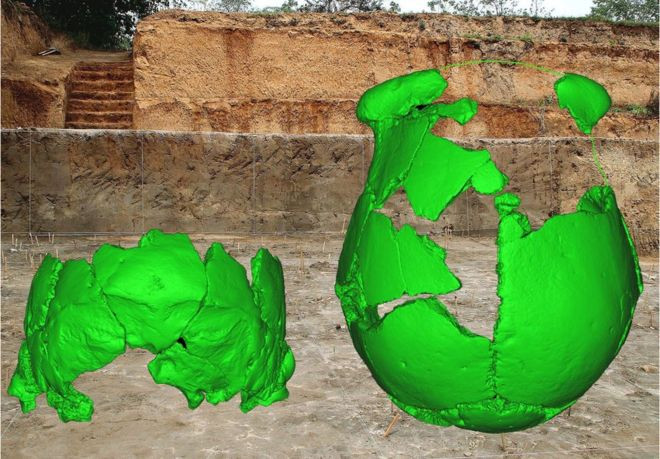Discover two mysterious ancient skulls in China
Scientists have discovered two mysterious ancient skulls in central China, which may belong to mankind that have never been known.
Two new intact skulls were found in Linh Canh, Xuchang City, Henan Province of China, dating from 105,000 to 125,000 years.
They have a blend of Neanderthals and modern humans, making scientists unable to identify any human skulls.
Scientists believe that it belongs to a species we have never known, which is the key to finding a new branch of humanity in East Asia.

Two unscathed skulls have just been found in China, which may be evidence of a new breed that has never been known.(Photo: Xiujie Wu.)
Many experts say the skull may belong to the Denisovans , whose relatives are close to the Neanderthals, who lived between 100,000 and 50,000 years ago.
It is estimated that about 0.1% of Denisovans used to live in China, based on the results of DNA tests found. Scientists had previously found a finger bone and several teeth in Siberia, and thought it was from the Denisovans.
"A lot of people question whether this is a Denisova's skull. If that is true, then this would be a very interesting finding. The Denisovans are very close to the Neanderthals that we know. "The ancient archaeologist Chris Stringer of London's Natural History Museum said.
However, if there is not much evidence of other DNA testing in the future, we will have two possibilities: either the skull belongs to a new type of person that has never been known, or it belongs to the Denisova who used to live. in East Asia.
" This is a big discovery, because the human fossils in East Asia are still so flawed, we don't have enough fossil bones to make a complete human skeleton ," said Katerina Harvati. about the Neanderthals at the University of Tübingen (Germany), said.
This finding also helps us learn more about the ancestral process of humanity since it appeared in Africa and evacuated to other areas in Asia, which didn't have any trace of long ago.
Collecting dark ancient skulls in East Asia is very important, helping explain the great migration of human ancestors, to become modern people like today.
Two newly found skulls have quite similar characteristics to modern humans, like the average forehead, the skull is quite small but contains a large brain; and many Neanderthal-like points like the semicircular ear, the skull extending backwards.
The time when people owned this skull lived in the Pleistocene, about 105,000 to 125,000 years ago, at which time a large part of the world was covered in snow and ice.
Researchers also found nearby there were bone samples of horses and cattle, such as the long-haired, giant-looking rhino or giant giraffe.
" China is rewriting the history of human ancestors. I feel very interested in this new discovery, " said paleontologist María Martinón-Torres, working at the University of London.
- Detecting two mysterious skulls of aliens
- Mysterious decoding of children's skulls scattered around the lake in Switzerland
- Mysterious skulls appear in Syria
- Detect strange skull
- Ancient Roman skulls under the Thames
- Mysterious giant skulls in the Death Valley
- Mask mysterious skulls in ancient Aztec temples
- Mysterious strange human skulls
- Legendary legend 'Crystal skull'
- Discovering more mysteries in ancient stone dumps Stonehenge 5,000 years in England
- Mysterious trophy trophy in South America
- Mysterious treasures in Roman town buried with jewels, dolls and miniature skulls
 Discovered an ancient centipede fossil 99 million years old
Discovered an ancient centipede fossil 99 million years old Discovered bat-like dinosaurs in China
Discovered bat-like dinosaurs in China Discovered a 200-year-old bronze cannon of the coast
Discovered a 200-year-old bronze cannon of the coast Discover 305 million-year-old spider fossils
Discover 305 million-year-old spider fossils